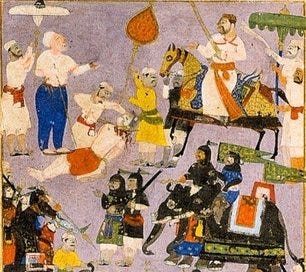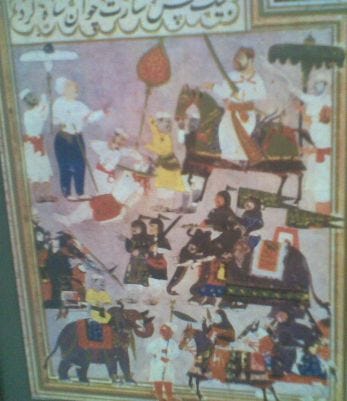The decline of Vijayanagara had actually begun after Sri Krishna Deva Raya's death with constant power struggles for the throne, and Rama Raya’s tactics of playing off one Bahmani Sultan against another, which was bound to backfire at some point or other, and it soon did. Tallikota in a sense was the climax to that.
Post the devastation of Ahmednagar by the combined force of Adil Shah and Rama Raya, peace was sought by restoring the territory of Kalyan to Bijapur. However Hussain Shah, again formed an alliance with Ibrahim Qutub Shah of Golkonda, and attacked Bijapur once more. Rama Raya, once again rushed to the aid of Bijapur, and a last minute defection by the Qutub Shah to Bijapur meant, that Hussain Shah, was compelled to retreat in the face of a humiliating defeat. Panagal and Ghanpur in Warangal, were ceded to Vijayanagara by Golkonda, which would be the last major success it had.
← Beginning of the End- Aliya Rama Raya
Tallikota- The End of Vijayanagara
Posted on December 4, 2014 by Ratnakar Sadasyula
In my last two posts, I had been looking at the decline of Vijayanagara, post Krishnadeva Raya, and Rama Raya’s tactics of playing off one Bahmani Sultan against another. As I had mentioned earlier, this tendency to play off one Bahmani Sultan against another was bound to backfire at some point or other, and it soon did.
Beheading of Rama Raya at Tallikota
Post the devastation of Ahmednagar by the combined force of Adil Shah and Rama Raya, peace was sought by restoring the territory of Kalyan to Bijapur. However Hussain Shah, again formed an alliance with Ibrahim Qutub Shah of Golkonda, and attacked Bijapur once more. Rama Raya, once again rushed to the aid of Bijapur, and a last minute defection by the Qutub Shah to Bijapur meant, that Hussain Shah, was compelled to retreat in the face of a humiliating defeat. Panagal and Ghanpur in Warangal, were ceded to Vijayanagara by Golkonda, which would be the last major success it had.
Rama Raya continued to attack the Bahmani domains, in spite of the peace treaties, which now angered Adil Shah, who sought to put him down. However Rama Raya’s formidable wealth from the sea trading on West Coast, revenue from his territories, and the huge Vijayanagara Army, meant it was impossible for one single ruler to defeat them. This is when Adil Shah’s close friends and advisers, suggested that since Vijayanagara could not be defeated by him alone, it would be better to form a federation of all the Bahmani sultans and wage a joint campaign.
Ali Adil Shah, immediately despatched an envoy to Ibrahim Qutub Shah, who readily accepted the offer. The Qutub Shah, then offered to negotiate between Adil Shah, and his arch rival, Ahmednagar’s Hussain Shah, emphasizing on the need for a common front to defeat the mighty Vijayanagara Empire. Hussain Shah’s daughter Chand Bibi was given in marriage to Ali Adil Shah along with Sholapur province, while his eldest son Murtiza, would marry Adil Shah’s sister. The marriages, sealed the alliance between Bijapur and Ahmednagar, giving shape to the common front. Along with the Sultans of Bidar and Berar, the grand alliance against Vijayanagara now took shape, and soon they began their campaign against it.
Tallikota, a small town lying on the Doni river, located in the present Bijapur district of Karnataka, was where the grand Bahmani alliance camped. It was the winter time, when the weather was dry and large armies could pass through. While the Bahmani armies were busy in arranging the transport for armies, and sending out scouts, at Vijayanagara, there was an air of casual indifference. Having seen many attacks from the Bahmani Sultans, that failed, the citizens of Vijayanagara, assumed this would be the same, unaware of the impending doom. It was life as usual in Vijayanagara, citizens going about their tasks, the carts taking the merchandise to the seaports, unaware of the grand alliance against it. Rama Raya was his usual imperious self, dismissing the enemy movements as of no consequence. It was this careless, lax attitude, that would dearly cost Vijayanagara.
Neverthless Rama Raya, ensured that the passage to Krishna river was blocked at all points. His brother Tirumala Raya with a cavalry of 20,000 and 100,000 infantry, was sent to cut off access to Krishna. His other brother Venkatadri marched with a large army, and finally Aliya Rama Raya, himself led the mighty Vijayanagara Army against the Bahmanis. It was a massive army, with Canareses, Telugu people from the frontier, Tamils from the deep South, Mysoreans and Malabarese, a cavalry of 100,000 and an infantry of 600,000.
With all access to the river banks cut off, the only way for the Bahmani Allies was to ford the Krishna, which was in possession of the Vijayanagara forces, lying in wait with cannons. The Bahmanis cleverly played a ruse, into tricking the defenders of the Krishna river, to believe they were attacking from another point, which made them desert the defense of the ford. The trick worked, as the Bahmanis finding the ford deserted and no defenses, and marched across it. The forces of Vijayanagara and the combined Bahmani Armies, met at Tallikota, a battle that would go down in history for it’s infamy.
January 23, 1565, the forces of Vijayanagara and Bahmanis clashed on the plains of Tallikota. Tirumala Raya, leading the left flank faced the forces of Bijapur, while Rama Raya, in the center was against Ahmednagar’s Hussain Nizam Shah, and Venkatadri on the right side was facing the forces of Golkonda and Bidar. The Bahmani forces had 3 layers of artillery, first one with heavy guns, and the light swivel guns in the rear, who in turn were backed by 2000 foreign archers. The assault from the Bahmani forces was furious, forcing the Vijayanagara Army to retreat back initially. However the Vijayanagara forces struck back vigorously with rocket batteries, under Venkatadri, and the heavy guns threw the Bidar forces into disarray, while Ibrahim Qutub Shah was forced to retreat. Both the left and right wings of the Bahmani forces were forced to fall back, after the furious assault by the Vijayanagara forces. The Nizam Shah now attacked the center of Vijayanagara, and inspite of his old age, Rama Raya, fought furiously like a man possesed. Around this time, the Muslim officers in Vijaynagara launched a subversive attack, and the forces were surrounded from all sides.Around 5000 members of the Vijayanagara army were killed, by the attack from all sides. Rama Raya’s elephant itself was struck by a cannon shard, and he fell from it, before he could get up, he was captured and taken as prisoner.
Rama Raya was taken as prisoner to Hussain Nizam Shah, and was given a choice of converting to Islam to be spared of his life. He however refused, and was immediately beheaded by the Bahmanis. Rama Raya’s head stuck on a long pole was displayed, and the Vijayanagara forces became demoralized seeing the death of their leader. Later it was believed, that Rama Raya’s headless body stuffed with straw was displayed in public at Ahmednagar, while his head was kept on a pole there. The Vijayanagara forces now demoralized retreated from the battle field, and soon it became a total rout, as the Bahmani forces fell upon the fleeing soldiers, and the land, the rivers ran red with blood. Venkatadri Raya was also killed, and in spite of Tirumala Raya’s best efforts, the artillery was exhausted, and the Vijayanagara army was effectively routed.
As the news of the rout at Tallikota, travelled to Hampi, the inhabitants were shocked, but still felt the enemy could not reach their impregnable city. However as more and more soldiers came back, the magnitude of the tragedy was beginning to unfold. Many chiefs who could afford, fled Hampi, taking whatever treasures they could lay their hands on. Tirumala Raya took the royal treasure on 1500 elephants, which consisted of gold, diamonds, the jewelled thrones, fled towards Penukonda( now in Anantapur district). On the way to Penukonda, the convoy was regularly attacked by bandits, robbers, led by some of the tribes like the Brinjaris, Lambadis.
Now it was apparent that the end was over, it was not just a disaster, it was apocalypse, a catacylsm. With most of the soldiers, chieftains, nobles having abandoned Hampi, the ordinary citizens were left at the mercy of the looters and the invaders. Robber tribes like Brinjaris, Lambadis swooped down on Hampi, carrying off whatever treasures they could lay their hands on. And after 3 days, the victorious Bahmani forces entered the city of Hampi, their objective was to raze and destroy Vijayanagara to the ground. Temples were broken down, the inhabitants were slaughtered mercilessly, the once stately palaces and buildings were now being burnt and reduced to rubble.
Statues were broken, even the huge Narasimha monolith had it’s limbs broken, the pavilions were destroyed, all the carvings were smashed. One of the world’s greatest and richest cities, was being looted, pillaged and ravaged like never before. This was not the way for a great empire to end, as the invaders demolished every inch with fire, sword, crowbars and axes. A proud and mighty empire was ravaged, it’s buildings, temples, palaces all demolished and ruined, it’s citizens massacred, and a whole lot of horrors were perpetrated. One of the world’s greatest empires and civilizations had been razed to the ground, never to rise again.








This History is sadly never taught to our younngsters.
Continued ignorance let's the Islamic pillage go on unchecked. Recent example - Thiru Parankundram or Skandha Giri being "Islamised" as Sikandar Malai.
Very few Tamils are aware of the devastating raids of Malik Kafur and Ulugh Khan which forced Sriranganatha (Sri Rangam) and Madurai Meenakshi (Madurai) into a long exile of 60 years ; the Madurai Sultanate Wreaked havoc on Sanathanies around this time of which most Tamils are unaware. Very, very sad.
Vandhe Matharam
Jai Shri Ram
tragic. vijayanagara had been the bulwark that rescued the south from cultural decimation. this was a real point of inflexion, and every Hindu must go to hampi on a pilgrimage to swear, "never again".